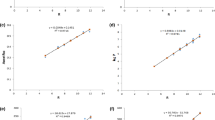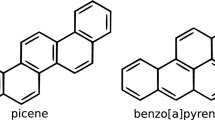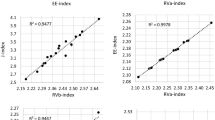Abstract
This study is directed toward assessing the predictive potential of eigenvalue-based topological molecular descriptors. The graph energy, Estrada index, resolvent energy, and the Laplacian energy were tested as parameters for the prediction of boiling points, heats of formation, and octanol/water partition coefficients of alkanes. It was shown that an eigenvalue-based molecular descriptor cannot be individually used for successful prediction of these physico-chemical properties, but the first Zagreb index, the number of zeros in the spectrum and the number of methyl groups must be also involved in the models. Performed statistics show that the models constructed using the Estrada index and resolvent energy are significantly better than ones with the energy of a graph and the Laplacian energy. Such a trend is even more noticeable in the case of octanol/water partition coefficients of alkanes.






Similar content being viewed by others
References
Roу K, Kar S, Das RN (2015) A primer on QSAR/QSPR modeling–fundamental concepts. Springer, Cham
Estrada E, Torres L, Rodrigues L, Gutman I (1998) An atom–bond connectivity index: modelling the enthalpy of formation of alkanes. Indian J Chem 37A:849–855
Zavitsas AA, Matsunaga N, Rogers DW (2008) Enthalpies of formation of hydrocarbons by hydrogen atom counting. Theoretical implications. J Phys Chem A 112:5734–5741. https://doi.org/10.1021/jp801152t
Yu J, Sumathi R, Green WH (2004) Accurate and efficient method for predicting thermochemistry of polycyclic aromatic hydrocarbons-bond-centered group additivity. J Am Chem Soc 126:12685–12700. https://doi.org/10.1021/ja048333+
Redžepović I, Marković S, Furtula B (2019) On structural dependence of enthalpy of formation of catacondensed benzenoid hydrocarbons. MATCH Commun Math Comput Chem 82:663–678
Allison TC, Burgess DR (2015) First-principles prediction of enthalpies of formation for polycyclic aromatic hydrocarbons and derivatives. J Phys Chem A 119:11329–11365. https://doi.org/10.1021/acs.jpca.5b07908
Teixeira AL, Leal JP, Falcao AO (2013) Random forests for feature selection in QSPR models—an application for predicting standard enthalpy of formation of hydrocarbons. J Cheminf 5:9–24. https://doi.org/10.1186/1758-2946-5-9
Dudek AZ, Arodz T, Galvez J (2006) Computational methods in developing quantitative structure–activity relationships (QSAR): a review. Comb Chem High Throughput Screen 9:213–228. https://doi.org/10.2174/138620706776055539
Todeschini T, Consonni V (2009) Molecular descriptors for chemoinformatics. Wiley, Weinheim. https://doi.org/10.1002/9783527628766
Mauri A, Consonni V, Todeschini R (2016) Molecular descriptors. Handbook of computational chemistry. Springer, Cham. https://doi.org/10.1007/978-94-007-6169-8_51-1
Devillers J, Balaban AT (1999) Topological indices and related descriptors in QSAR and QSPR. Gordon & Breach, Amsterdam
Talevi A, Bellera CL, Di Ianni M, Duchowicz PR, Bruno–Blanch LE, Castro EA (2012) An integrated drug development approach applying topological descriptors. Curr Comput Aided Drug Des 8:172–181. https://doi.org/10.2174/157340912801619076
Zanni R, Galvez–Llompart M, García–Domenech R, Galvez J (2015) Latest advances in molecular topology applications for drug discovery. Expert Opin Drug Discov 10:945–957. https://doi.org/10.1517/17460441.2015.1062751
Dearden JC (2017). In: Roy K (ed) Advances in QSAR modeling—applications in pharmaceutical, chemical, food, agricultural and environmental sciences. Springer, Cham. https://doi.org/10.1007/978-3-319-56850-8_2
Li X, Shi Y, Gutman I (2012) Graph energy. Springer, New York. https://doi.org/10.1007/978-1-4614-4220-2
Diudea MV, Pirvan–Moldovan A, Pop R, Medeleanu M (2018) Energy of graphs and remote graphs in hypercubes, rhombellanes and fullerenes. MATCH Commun Math Comput Chem 80:835–852
Ma X (2019) A low bound on graph energy in terms of minimum degree. MATCH Commun Math Comput Chem 81:393–404
Estrada E (2000) Characterization of 3D molecular structure. Chem Phys Lett 319:713–718. https://doi.org/10.1016/S0009-2614(00)00158-5
Hayat S, Imran M, Liu JB (2019) Correlation between the Estrada index and π-electronic energies for benzenoid hydrocarbons with applications to boron nanotubes. Int J Quantum Chem. https://doi.org/10.1002/qua.26016
Gutman I, Furtula B, Zogić E, Glogić E (2016) Resolvent energy of graphs. MATCH Commun Math Comput Chem 75:279–290. http://match.pmf.kg.ac.rs/electronic_versions/Match75/n2/match75n2_279-290.pdf
Das KC (2019) Conjectures on resolvent energy of graphs. MATCH Commun Math Comput Chem 81:453–464
Redžepović I, Furtula B (2020) On relationships of eigenvalue–based topological molecular descriptors. Acta Chim Slov 67:312–318. https://doi.org/10.17344/acsi.2019.5520
Redžepović I, Furtula B (2020) On degeneracy of A-eigenvalue-based molecular descriptors and r-equienergetic chemical trees. MATCH Commun Math Comput Chem 84:385–397
Gutman I, Zhou B (2006) Laplacian energy of a graph. Lin Algebra Appl 414:29–37. https://doi.org/10.1016/j.laa.2005.09.008
Basak S, Niemi G, Veith G (1991) Predicting properties of molecules using graph invariants. J Math Chem 7:243–272. https://doi.org/10.1007/BF01200826
Basak S, Nikolić S, Trinajstić N, Amić D, Bešlo D (2000) QSPR modeling: graph connectivity indices versus line graph connectivity indices. J Chem Inf Comput Sci 40:927–933. https://doi.org/10.1021/ci990119v
Trinajstić N, Nikolić S, Basak S, Lukovits I (2001) Distance indices and their hyper-counterparts: intercorrelation and use in the structure-property modeling. SAR QSAR Environ Res 12:31–54. https://doi.org/10.1080/10629360108035370
Pedregosa F, Varoquaux G, Gramfort A et al (2011) Scikit-learn: machine learning in python. J Mach Learn Res 12:2825–2830
Wiener H (1947) Structural determination of paraffin boiling points. J Am Chem Soc 69:17–20. https://doi.org/10.1021/ja01193a005
Balaban TA (1982) Highly discriminating distance based numerical descriptor. Chem Phys Lett 89:399–404. https://doi.org/10.1016/0009-2614(82)80009-2
Randić M (1975) Characterization of molecular branching. J Am Chem Soc 97:6609–6615. https://doi.org/10.1021/ja00856a001
NIST Chemistry Webbook. https://webbook.nist.gov/chemistry Accessed 5 Dec 2019
PubChem. https://pubchem.ncbi.nlm.nih.gov Accessed 5 December 2019
Wehrens R, Linden WE (1997) Bootstrapping principal component regression models. J Chemom 11:157–171. https://doi.org/10.1002/(SICI)1099-128X
Wehrens R, Putter H, Buydens MCL (2000) The bootstrap: a tutorial. Chemom Intell Lab Syst 54:35–52. https://doi.org/10.1016/S0169-7439(00)00102-7
Furtula B, Gutman I (2015) A forgotten topological index. J Math Chem 53:1184–1190. https://doi.org/10.1007/s10910-015-0480-z
Leahy DE (1986) Intrinsic molecular volume as a measure of the cavity term in linear solvation energy relationships: Octanol-water partition coefficients and aqueous solubilities. J Pharm Sci 75:629–636. https://doi.org/10.1002/jps.2600750702
Acknowledgements
This work was supported by the Serbian Ministry of Education, Science and Technological Development (Agreement No. 451-03-68/2020-14/200122).
Author information
Authors and Affiliations
Corresponding author
Electronic Supplementary Material
Below is the link to the electronic supplementary material.
Rights and permissions
About this article
Cite this article
Redžepović, I., Furtula, B. Predictive potential of eigenvalue-based topological molecular descriptors. J Comput Aided Mol Des 34, 975–982 (2020). https://doi.org/10.1007/s10822-020-00320-2
Received:
Accepted:
Published:
Issue Date:
DOI: https://doi.org/10.1007/s10822-020-00320-2




